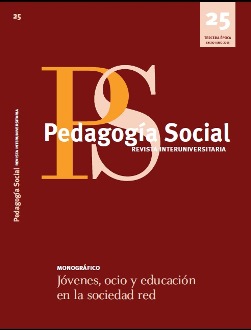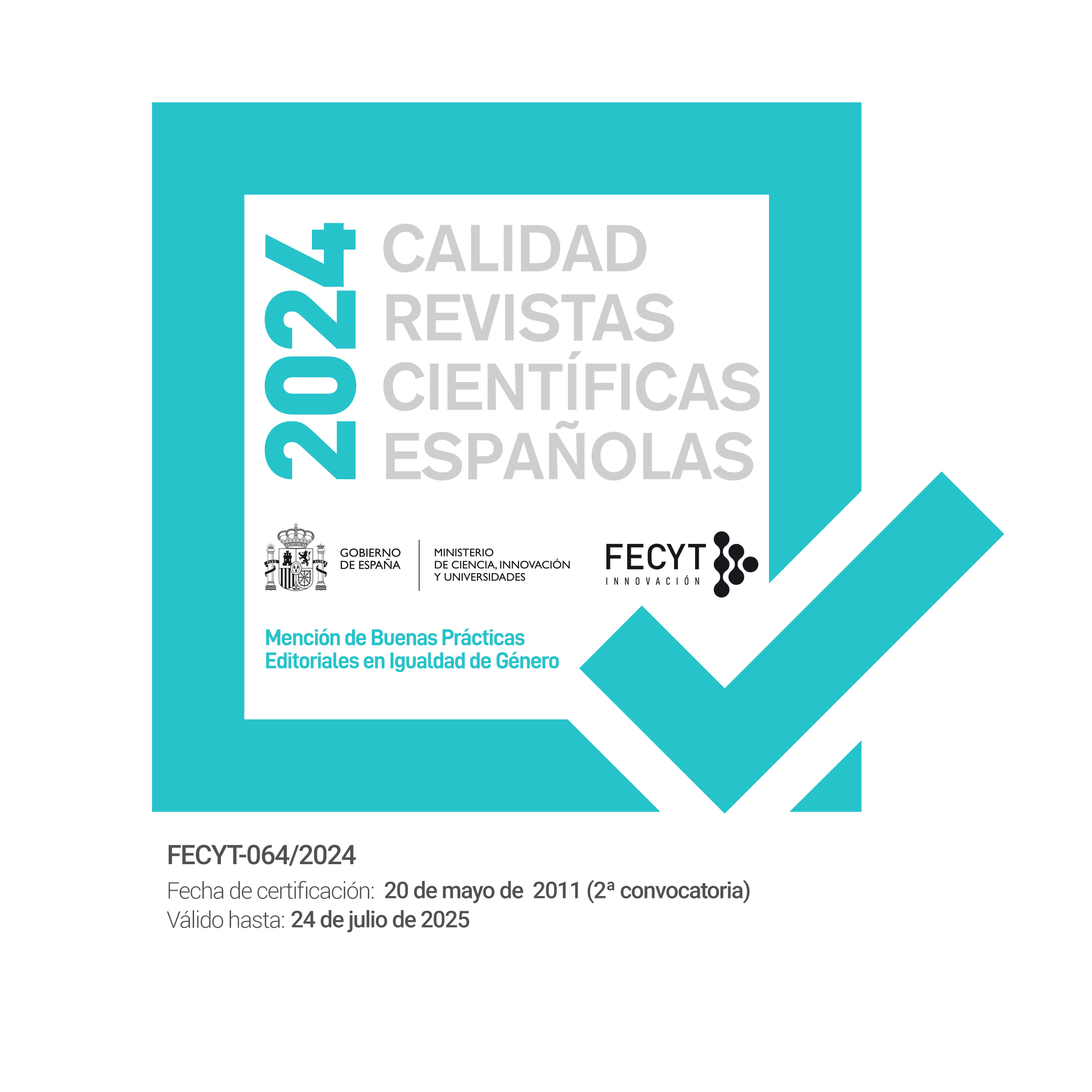Violencia en parejas jóvenes: primeros datos sobre incidencia de victimización y perpetración en Asturias
DOI:
https://doi.org/10.7179/PSRI_2015.25.11Keywords:
Violencia, motivos, relaciones de pareja, educación secundaria, prevenciónAbstract
En el presente artículo se presentan los resultados, de carácter descriptivo, del estudio sobre la incidencia y tipología de conductas violentas en parejas jóvenes. Se recogen datos de 740 alumnos y alumnas de 3º y 4º de E.S.O. y 1º y 2º de bachiller de nueve centros públicos de Asturias. El 43,8% de los participantes son chicos y el 55,9% son chicas. El 80,7% de las chicas y el 80,9% de los chicos ha tenido alguna pareja, bien en el pasado o actualmente.
Para la recogida de información se ha elaborado un cuestionario compuesto por 62 ítems que reflejan conductas concretas, representando estas las distintas tipologías de violencia física, psicológica y sexual a través de una escala que indica la frecuencia de cada una de ellas.
La mayor incidencia de violencia, tanto ejercida como recibida, corresponde a situaciones de violencia psicológica, seguida de las conductas de agresión física y, por último, aquellas referidas a violencia sexual.
Los resultados ponen de manifiesto la necesidad de continuar llevando a cabo trabajos que valoren la magnitud de este fenómeno, el cual tiene unas características concretas en un momento vital tan relevante como es la adolescencia. Es durante este período cuando suelen tener lugar las primeras relaciones de pareja, las cuales, en muchas ocasiones, tienen gran influencia en las vinculaciones que se desarrollarán en el futuro. Se señala, como una de las cuestiones claves, los motivos por los que chicos y chicas ejercen o reciben alguna de las acciones especificadas en el cuestionario, pues de la interpretación y el valor que dan a estas situaciones puede depender cómo las afronten y vivan en el marco de sus relaciones interpersonales.
Downloads
References
Aguilar Ródenas, C.; Alonso Olea, M.J.; Melgar, P. y Molina Roldán, S (2009). Violencia de género en el ámbito universitario: medidas para su superación. Pedagogía Social. Revista Interuniversitaria, 16, 85-94.
Archer, J. (2002). Sex differences in physically aggressive acts between heterosexual partners: A meta-analytic review. Aggression and Violent Behavior, 7(4), 313-351. DOI: 10.1016/S1359-1789(01)00061-1
Boira, S.; Carbajosa, P. y Macuello, Ch. (2013). La violencia en la pareja desde tres perspectivas: Víctimas, agresores y profesionales. Pychosocial Intervention, 22 (2), 125-33. Doi: 10.5093/in2013a15
Capaldi, D. M., Shortt, J. W., y Kim, H. K. (2005). A life span developmental system perspective on aggression toward a partner. En W. M. Pinsof y J. Lebow (Eds.), Family Psychology: the Art of the Science. Oxford, United Kingdom: Oxford Press.
Cascardi, M., O'Leary, K. D., Lawrence, E. E., & Schlee, K. A. (1995). Characteristics of women physically abused by their spouses and who seek treatment regarding marital conflict. Journal of Consulting and Clinical Psychology, 63(4), 616–623. Doi: 10.1037//0022-006x.63.4.616
Ely, G., Dulmus, C. N., y Wodarski, J. S. (2002). Adolescent dating violence. En Rapp-Paglicci, L.A.; Roberts, A.R. y Wodarski, J.S. (Eds.), Handbook of violence (pp. 33–53). New York: John Wiley & Sons.
Fernández-Fuertes, A. y Fuertes, A. (2010). Physical and psychological aggression in dating relationships of Spanish adolescents: motives and consequences. Child Abuse and Neglect, 34 (3), 183-191. Doi: 10.1016/j.chiabu.2010.01.002
Fernández González, L.; O´Leary, K.D. y Muñoz Rivas, M.J. (2013). We are not joking need for controls in reports of dating violence. Journal of Interpersonal Violence, 28 (3), 602-620. Doi: 10.1177/0886260512455518
Follingstad, D.R., Wright, S., Lloyd, S. y Sebastian, J.R. (1991). Sex Differences in Motivations and Effects in Dating Violence. Family Relations, 40 (1), 51-57. Doi: 10.2307/585658
Foshee, V., y Reyes, H. (2011). Dating abuse: prevalence, consequences and causes. In J. R. Roger (Eds), Encyclopedia of adolescence (pp. 602-615). New York: Springer. Doi: 10.1007/978-1-4419-1695-2_51
Foshee, V., Bauman, K., Ennett, S., Suchindran, C., Benefield, T., y Linder, F. (2005). Assessing the effects of the dating violence prevention program "Safe Dates" using random coefficient regression modeling. Prevention Science, 6 (3), 245-258. Doi: 10.1007/s11121-005-0007-0
Foshee, V. A., Bauman, K. E., Linder, F., Rice, J., y Wilcher, R. (2007). Typologies of adolescent dating violence: Identifying typologies of adolescent dating violence perpetration. Journal of Interpersonal Violence, 22, 498-519. Doi: 10.1177/0886260506298829
Foshee, V. A., Benefield, T. S., Ennett, S. T., Bauman, K. E., y Suchindran, S. (2004). Longitudinal predictors of serious physical and sexual dating violence victimization during adolescence. Preventive Medicine, 39-1007-1016. Doi: 10.1016/j.ypmed.2004.04.014
Gárate, M.; Tejerina, I.; Melero, M.A.; Echevarría, E. y Gutiérrez Sebastián, R. (2008). El torno al sexismo y la enseñanza de textos argumentativos y narrativos. Revista OCNOS, 4, 21-34.
González Méndez, R. y Santana Hernández, J.D. (2001). La violencia en parejas jóvenes. Psicothema, 13 (1), 127-13.
Gonzalez Méndez, R. y Hernández Cabrera, J.A. (2009). Play context, commitment, and dating violence. A structural equation model. Journal of Interpersonal Violence, 24 (9), 1518-1535. Doi: 10.1177/0886260508323666
Harned, M.S. (2001). Abused women or abused men? An examination of the context and outcomes of dating violence. Violence and Victims, 16(3), 269-85.
Hernando Gómez, A.; García Rojas, A.D. y Montilla Coronado, M.V.C. (2012). Exploración de las actitudes y conductas de jóvenes universitarios ante la violencia en las relaciones de pareja. Revista Complutense de Educación, 23 (2), 427-441. Doi: 10.5209/rev_rced.2012.v23.n2.40036
Hettrich, E.L. y O’Leary, K.D. (2005). Females’ Reasons for their physical aggression in dating relationships. Manuscrito no publicado. Stony Brook University, Stony Brook. NY
Johnson, M. P. (1995). Patriarchal terrorism and common couple violence: Two forms of violence against women. Journal of Marriage and the Family, 57, 283-294. Doi: 10.2307/353683
Kanin, E.J. (1957). Male aggression in dating-courting relations. American Journal of Sociology, 63 (2), 197-204. Doi: 10.1086/222177
Kernsmith, P. (2005). Exerting power or striking back: A gendered comparison of motivations for domestic violence perpetration. Violence and Victims, 20 (2), 173–185. Doi: 10.1891/088667005780905605
Makepeace, J. M. (1981). Courtship violence among college students. Family Relations, 30 (1), 97–102. Doi: 10.2307/584242
Makepeace, J.M. (1986). Gender differences in courtship violence victimization. Family Relations, 35, 383-388. Doi: 10.2307/584365
Menesini, E., Nocentini, A., Ortega-Rivera, J., Sánchez, V., y Ortega, R. (2011). Reciprocal involvement in adolescent dating aggression: An Italian–Spanish study, European Journal of Developmental Psychology, 8 (4), 437-451. Doi: 10.1080/17405629.2010.549011
Moral de la Rubia, J.; López Rosales, F.; Díaz Loving, R. y Cienfuegos Martínez, Y.I. (2011). Diferencias de género en afrontamiento y violencia en la pareja. Revista CES Psicología, 4 (2), 29-46. Doi: 10.1080/02134748.2013.878570
Muñoz-Rivas, M.J, Graña, J.L. O'Leary, K.D. y González, M.P. (2007). Aggression in adolescent dating relationships: prevalence, justification, and health consequences. Journal of Adolescent Health, 40 (4), 298–304. Doi: 10.1016/j.jadohealth.2006.11.137
Muñoz Rivas, M.J.; Graña, J.L; O´Leary, K.D. y González, M.P. (2009). Prevalence and predictors of sexual aggression in dating relationships of adolescents and young adults. Psicothema, 21 (2), 234-240
Nocentini, A., Menesini, E., y Pastorelli, C. (2010). Physical Dating Aggression growth during adolescence. Journal of Abnormal Child Psychology, 38, 353-365. Doi: 10.1007/s10802-009-9371-8
O’Keefe, M. (1998). Factors mediating the link between witnessing interparental violence and dating violence. Journal of Family Violence, 13 (1), 39-57. Doi: 10.1023/A:1022860700118
Padrós Cuxart, M.; Melgar Alcantud, P. y Aubert Simon, A. (2010). Modelos de atracción de los y las adolescentes.Contribuciones desde la socialización preventiva de la violencia de género. Pedagogía Social. Revista Interuniversitaria, 17, 73-82.
Sánchez, V., Ortega-Rivera, J., Ortega, R., y Viejo, C. (2008). Las relaciones sentimentales en la adolescencia: satisfacción, conflictos y violencia. Escritos de Psicología, 2, 97-109
Shorey, R. C., Meltzer, C., y Cornelius, T. L. (2010). Motivations for self-defensive aggression in dating relationships. Violence and Victims, 25, 662-676. Doi: 10.1891/0886-6708.25.5.662
Soriano Díaz, A. (2011). La violencia en las relaciones de pareja en estudiantes universitarios. Propuestas educativas. Pedagogía Social. Revista Interuniversitaria, 18, 87-97.
Stets, J. E., y Hammons, S. A. (2002). Gender, control, and marital commitment. Journal of Family Issues, 23 (1), 3–25. Doi: 10.1177/0192513X02023001001
Straus, M.A. (2004). Prevalence of violence against dating partners by male and female university students worldwide. Violence Against Women, 10 (7), 790-811. Doi: 10.1177/1077801204265552
Straus, M. A. (2011). Gender symmetry and mutuality in perpetration of clinical-level partner violence: Empirical evidence and implications for prevention and treatment. Aggression and Violent Behavior, 16, 279-288. Doi: 10.1016/j.avb.2011.04.010
Swahn, M., Alemdar, M., y Whitaker, D. (2010). Nonreciprocal and reciprocal dating violence and injury occurrence among urban youth. Brief Research Report, XI, 264-268.
Trujano, P. y Mata, E. (2002). Relaciones violentas en el noviazgo: un estudio exploratorio.
Psicología Conductual, 10, 389-408.
Walley-Jean, J. C. y Swan, S. (2009). Motivations and Justifications for Partner Aggression in a Sample of African American College Women. Journal of Aggression, Maltreatment & Trauma, 18 (7), 698-717. Doi: 10.1080/10926770903231759
Downloads
Additional Files
Published
How to Cite
Issue
Section
License
Copyright (c) 2014 Pedagogía Social. Revista Interuniversitaria

This work is licensed under a Creative Commons Attribution-NonCommercial 3.0 Unported License.
Copyright and right to archive
The published version of the articles can be self-archived by their authors in open access institutional and thematic repositories. However, Pedagogía Social. Revista Interuniversitaria must authorize partial or global reutilisation on new papers or publications.
Published papers must be cited including the title of the journal Pedagogía Social. Revista Interuniversitaria, issue, pages and year of publication
Ethical responsibilities
Pedagogía Social. Revista Interuniversitaria does not accept any material that has been previously published in other documents or publications. Authors are responsible for obtaining the required permissions for partial or global reproduction any material from other publications, and to correctly quote its origin.
Pedagogía Social. Revista Interuniversitaria is obliged to detect and report fraudulent practices.
Only those who have intellectually contribute to the development of the paper must appear as authors.
The journal expects authors to declare any commercial partnership that might entail a conflict of interest with respect to the submitted article.
Authors must mention in the article, preferably in the “methodology” section, that the procedures used during the samplings and controls have been made after getting informed consent.
The journal will not use any received contribution in a way other than the goals described in these guidelines.
Copyright Notice
© Pedagogía Social. Revista Interuniversitaria. Papers published in both the printed and online versions of this Journal are property of Pedagogia Social. Revista Interuniversitaria, being required to cite the source in any partial or total reproduction.
Unless otherwise stated, all content of this electronic journal is distributed under "Creative Commons Attribution-Non commercial 3.0 Spain" (CC-by-nc) license for use and distribution. The informative version and the legal text of this license is available here. This has to be expressly stated in this way when necessary.






